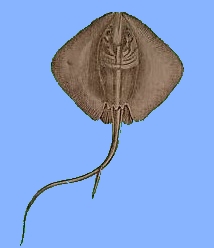Texas A&M-Corpus Christi Develops Plan to Conserve Stingrays
News Release
Texas A&M University-Corpus Christi
22nd July 2013
———————-
Texas A&M-Corpus Christi Develops Plan to Conserve Stingrays, Prevent Growing Threats Worldwide
 CORPUS CHRISTI, Texas – Some species of stingrays, whose diets occasionally include economically-valuable shellfish, are being considered “pests” to fishermen. One Texas A&M-Corpus Christi scientist says this could lead to a decline in the rays through increased uncontrolled “kill tournaments” in Chesapeake Bay, home to the largest estuary in the United States.
CORPUS CHRISTI, Texas – Some species of stingrays, whose diets occasionally include economically-valuable shellfish, are being considered “pests” to fishermen. One Texas A&M-Corpus Christi scientist says this could lead to a decline in the rays through increased uncontrolled “kill tournaments” in Chesapeake Bay, home to the largest estuary in the United States.
Dr. Matt Ajemian, a Research Associate at the Harte Research Institute at Texas A&M University-Corpus Christi, has studied this increased stingray targeting, which poses a serious threat to marine environments. He is researching the current knowledge and history of the stingrays, their behaviors, and their populations worldwide, to encourage sustainable use of rays.
“These fishermen don’t understand the biology and ecology of these ray species,” said Ajemian. “Our focus is to develop conservation measures for these ‘hard-eating’ stingrays.”
“Hard-eating” stingrays are a source of food for large sharks, he says. The rapid decline of these stingrays could cause a worldwide disruption in the food chain. These “hard-eating” species have some of the lowest reproductive rates among marine fish, which Ajemian says also contributes to their quick decline in numbers immediately after their populations are fished. There is also evidence that bottom-feeding stingrays provide benefits to other animals living in the seabed.
“Hard-eating” stingrays, which can be found in subtropical to temperate waters and include the cownose and eagle rays, consume hard-shelled marine critters like clams, scallops, oysters, and snails.
Ajemian says that the “kill tournaments,” mostly sponsored by bowfishing clubs, occur primarily in Chesapeake Bay in Virginia and Maryland. And, although there are no organized tournaments along the Gulf Coast, there are reports of bowhunters targeting rays from the region.
Currently, Ajemian is collaborating with the Mote Marine Laboratory in Sarasota, Fla., to develop a research program focused on spotted eagle rays that have been the target of a harpoon fishery in the southern Gulf of Mexico.
Earlier this month, Ajemian and Dr. Julie Neer of the South Atlantic Fisheries Management Council assembled the first symposium to address the stingrays at the 2013 American Elasmobranch Society (AES) annual meeting.
“This meeting served as a platform for scientists to review research on these animals and make recommendations for future management,” said Ajemian. “We hope to shift the negative attention associated with these species and increase awareness of the potential positive impacts of these species in marine food webs, including their potential ecotourism value.”
The symposium, part of the Joint Meeting of Ichthyologists and Herpetologists, brought together leading “hard-eating” (durophagous) stingray experts from the United States, Canada, Germany, Japan, and Mexico; non-profit organizations; and fisheries management agencies. The researchers reviewed current and past research on these animals so that they could use these findings to make recommendations to adequately conserve and manage “hard-eating” stingrays.
The first step was developing a resolution to alert the Virginia Marine Products Board of the vulnerability of cownose rays (marketed as “Chesapeake Ray”) to overexploitation. The resolution received unanimous support by the AES.
Ajemian was awarded a $10,250 grant from the Save Our Seas Foundation to host the symposium. He is working with researchers, compiling data on various stingray topics to publish the findings in an upcoming issue of the Environmental Biology of Fishes.
Source: Texas A&M University-Corpus Christi
